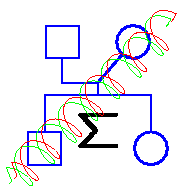
1. The data for this question come
from a study by Dr. Arno Motulsky and coworkers, and
are published in Thompson et al. (1988; Am.J.Hum.Genet, 42, 113-124).
There were three population samples (all from around Seattle),
(Caucasian, African American, and
Japanese American), and three tightly linked diallelic loci,
designated M, P and S.
In the Caucasian sample of 205 individuals typed at the
P and M loci, the counts of the two-locus phenotypes were
143, 35, 3, 17, 5, 0, 2, 0, and 0, respectively, for the nine types
P1P1,M1M1;
P1P1,M1M2;
P1P1,M2M2;
P1P2,M1M1;
P1P2,M1M2;
P1P2,M2M2;
P2P2,M1M1;
P2P2,M1M2;
P2P2,M2M2.
Use the EM algorithm to estimate the 4 haplotype frequencies
q11, q12, q21 and q22
of haplotypes
P1M1,
P1M2,
P2M1 and
P2M2.
2. This very small example is unrealistic, but shows the problem that
can arise in trying to use the EM algorithm to estimate haplotype frequencies.
We have a sample of just one individual who is heterozygous at both of
two loci: A1A2, B1B2.
Denote the frequencies of the four haplotypes
A1B1,
A1B2,
A2B1, and
A2B2,
by
q11
q12
q21 and
q22.
Show that there are two maximum likelihood estimates (of equal likelihood):
q11 = q22 = 1/2,
q12 = q21 = 0 and
q12 = q21 = 1/2,
q11 = q22 = 0.
What will the EM algorithm do?
3. A pair of brothers, A and B, marry a pair of sisters, A* and B*.
A and A* have a son D, and B and B* have a daughter E. Thus D and E
are double first cousins.
We consider identity-by-descent (IBD) at a single locus.
You may assume the kinship coefficient between a pair of sibs is 1/4.
(a) What is the probability that D and E receive IBD genes from their fathers?
(b) What is the probability that D and E share neither their maternal genes
nor their paternal genes?
(c) What is the kinship coefficient between D and E ?
(d) D and E now produce a child H.
What is the inbreeding coefficient of D?
What is the inbreeding coefficient of H?
Ans: 1/4, 9/16, 1/8 for (a), (b) and (c).
4. (based on Lange Ch 5 #3)
A brother-sister full-sib pair, A and B,
(mice, not humans) produce two offspring,
D and E.
(The kinship coefficient of full sibs is 1/4.)
(a) What is the inbreeding coefficient of D ?
(b) What is the kinship coefficient between D and B ?
(c) What is the kinship coefficient between D and E ?
(d) What is the probability D and E carry 4 IBD genes at a locus ?
(e) What is the probability D and E each carries two IBD genes at a locus,
but these are different genes?
(For (d) and (e), it is easiest to just draw a picture and count the ways.)
Answers (?): 1/4, 3/8, 3/8, 1/16, 1/32